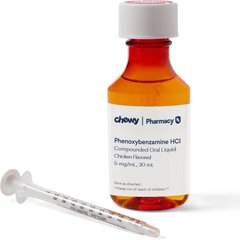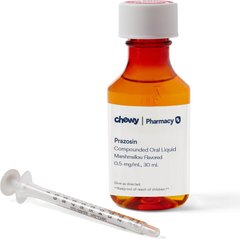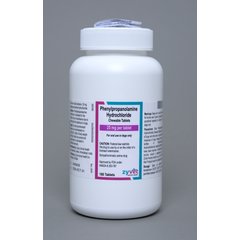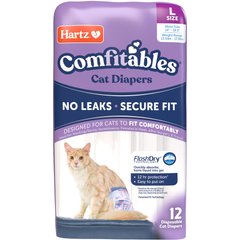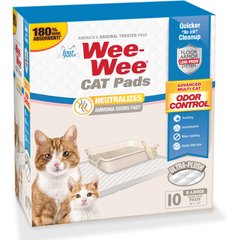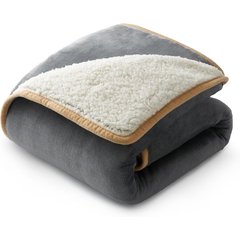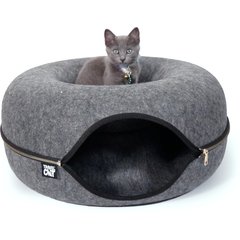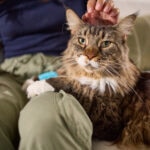What Is Feline Urinary Incontinence? How Is It Treated?
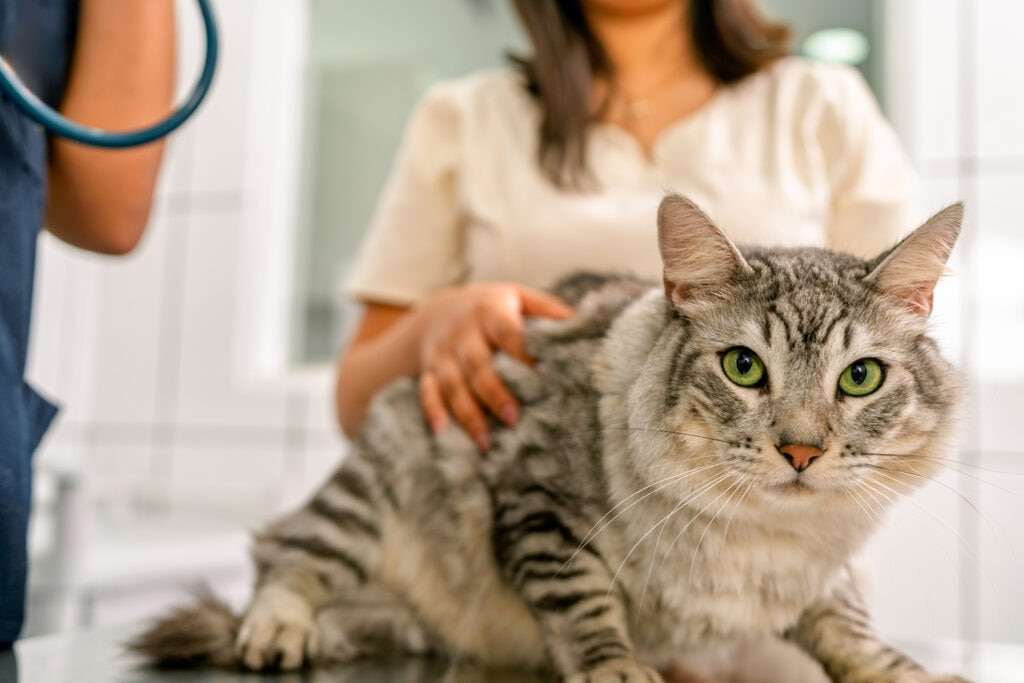
Photo by Guillermo Spelucin Runciman/iStock/Getty Images Plus
If you’ve noticed your cat leaving wet spots around the house, they may be unintentionally leaking urine—a condition known as feline urinary incontinence.
Urinary incontinence in cats is not very common. It’s often confused with other, more frequently diagnosed conditions such as feline idiopathic cystitis.
However, any change in a cat’s urinary habits should always be assessed by a veterinarian.
If it appears that your cat can’t urinate or is in significant discomfort, you could be dealing with a medical emergency—get them to a veterinarian immediately.
Key Takeaways
- Feline urinary incontinence is the involuntary leakage of urine and can have many causes.
- Signs include wet spots where your cat sleeps, damp fur around the hindquarters, and urine dribbling without your cat seeming to notice.
- Treatment depends on the underlying cause and may include medications, surgery, or management techniques to keep your cat comfortable and your home clean.
- With proper veterinary care and home management, cat incontinence can improve or even completely resolve.
What Is Feline Urinary Incontinence?
When a cat involuntarily leaks urine, they have a condition known as urinary incontinence.
This is different from a cat who sprays or intentionally urinates outside of the litter box, which are much more common problems for cat parents. One study found that urinary incontinence accounted for only about 4% of lower urinary tract disease in cats.
Any cat can develop urinary incontinence regardless of age, sex, or breed. However, Manx cats and other breeds with abnormal tails are prone to spinal cord abnormalities that can affect bladder control.
What Are the Signs of Feline Urinary Incontinence?
The signs of feline urinary incontinence can vary, depending on what’s causing the problem and how severe it is. You might notice:
- Wet spots where your cat has been sleeping or resting
- Urine leakage that your cat doesn’t seem aware of
- Damp, urine-stained fur around your cat’s hind end
- Skin irritation or redness around the hindquarters from urine scald (urine irritation or burn)
- Normal urination behavior at other times (your cat may still use the litter box)
Some cats only leak urine when sleeping, while others may dribble throughout the day.
With cat incontinence, you’ll likely find multiple small urine spots around your home, unlike the larger puddles typically left when cats intentionally urinate outside the litter box.
What Causes Feline Urinary Incontinence?
Feline incontinence can develop because of a variety of underlying conditions.
The most common causes include:
- Spinal cord problems: Congenital abnormalities (common in Manx cats), injuries, tumors, and other disorders affecting the spine—especially near the tail—can disrupt nerve signals that control the bladder. In one study, spinal cord problems were the most common cause of incontinence, affecting 40% of the cats included in the study.
- Conditions affecting the urethra: The urethra carries urine from the bladder out of the body. Problems affecting the urethra, including trauma, inflammation, masses, strictures (narrowing), and congenital malformations, are the second leading cause of urinary incontinence in cats.
- Bladder problems: Inflammation, infections, bladder stones, tumors, or issues affecting the bladder’s nerves or muscles can make it difficult to hold urine properly.
- Ectopic ureters: The ureters carry urine from the kidneys to the bladder, but sometimes they form abnormally and drain into the urethra or another site, leading to incontinence.
- Other conditions: Incontinence can occur with nervous system disorders (such as feline dysautonomia). Cats with feline leukemia virus (FeLV) infections may also be at higher risk.
How Do Veterinarians Treat Feline Urinary Incontinence?
If your cat can’t pee or is in serious discomfort, get them to a vet immediately—you might be dealing with a urinary blockage, which is a true emergency.
Otherwise, make an appointment with your veterinarian as soon as possible. Incontinence is often linked to serious underlying conditions that need timely diagnosis and treatment.
Your veterinarian will ask about your cat’s symptoms and health history and perform a thorough physical examination.
Diagnostic tests are also usually needed. They may include:
- Urinalysis and urine culture to look for infection, inflammation, or crystals associated with bladder stones
- Blood tests to evaluate kidney function, FeLV status, and overall health
- X-rays or ultrasound to visualize the bladder, urethra, and spine
- Specialized tests such as contrast studies (X-rays with dye), cystoscopy (using a tiny camera to look inside the bladder and urethra), or urodynamic studies (to measure bladder function)
Once your vet identifies the cause, they can recommend appropriate treatment.
Medications may be available to lessen or eliminate your cat’s incontinence. For example, a veterinarian could prescribe:
- Antibiotics if a bacterial infection is involved
- Phenoxybenzamine or prazosin to help urine flow more easily out of the bladder. Phenoxybenzamine and prazosin are currently not FDA-approved as veterinary medication. However, veterinarians can prescribe some human drugs in animals in certain qualifying circumstances. This is called off-label use because the use is not included in the drug’s labeling. Your veterinarian will determine whether this medication could be right for a cat experiencing incontinence issues.
Recommended Products
Phenylpropanolamine to help the bladder retain urine. Phyenlpropanolamine is an FDA-approved and veterinarian–prescribed medication used to treat urinary incontinence in dogs. However, veterinarians can prescribe animal drugs to other species in certain qualifying circumstances. This is called off-label use because the use is not included in the drug’s labeling. Your veterinarian will determine whether this medication could be right for a cat experiencing incontinence issues.
Recommended Product
Surgery may be needed to remove tumors or correct anatomical abnormalities like ectopic ureters.
Additional treatments and expected outcomes will depend on the exact cause of your cat’s incontinence.
How Can I Help My Incontinent Cat Feel More Comfortable?
If treatment doesn’t fully resolve your cat’s incontinence, adjustments at home can help improve your cat’s quality of life and keep your house clean.
Environment
- Use disposable cat diapers
Recommended Product
- Place waterproof pads or washable blankets in your cat’s favorite sleeping spots
Recommended Products
- Provide waterproof cat beds
Recommended Products
- Make sure to have multiple clean litter boxes that are easy for your cat to use
Recommended Products
Hygiene and Skin Care
- Keep the fur around your cat’s hind end trimmed short
Recommended Product
- Gently clean your cat’s hindquarters daily with pet-safe wipes
Recommended Product
- Apply cat-safe barrier cream to prevent urine scald
Recommended Product
Bathe your cat more frequently if needed, using a gentle, cat-friendly shampoo
Recommended Product
Cats with incontinence are at higher risk for urinary tract infections (UTIs).
Follow your veterinarian’s recheck schedule and report any changes in your cat’s condition promptly.
How Do I Prevent Feline Urinary Incontinence in My Cat?
While not all causes of urinary incontinence can be prevented, these steps can reduce your cat’s risk:
- Monitor your cat’s urinary health: Watch for changes in urination habits, difficulty urinating (straining), or signs of pain. Early intervention can prevent complications that might lead to incontinence.
- Provide regular veterinary care: Yearly or twice-yearly checkups help catch health problems early, when treatment is most effective.
- Minimize injury risk: Keep your cat indoors to prevent car accidents, animal attacks, or falls.
- Avoid at-risk breeds: If you’re looking to bring home a new cat, avoid breeds that have abnormal tail anatomy, which can increase the risk of urinary incontinence and other health problems.
FAQs About Feline Urinary Incontinence
What can you do for an older incontinent cat?
Older cats with incontinence should be examined by a veterinarian.
After identifying the cause of the incontinence, they can recommend medications or other forms of treatment. Managing the home environment with waterproof bedding or cat diapers can help keep your senior cat comfortable.
Why is my older male cat leaking urine while resting?
Older male cats can leak urine while resting for many reasons, including spinal cord problems, urinary tract infections, inflammation of the bladder or urethra, or partial urinary blockages. A veterinary examination is essential to determine the cause and then guide treatment.
Does kidney failure cause incontinence in cats?
Kidney failure itself doesn’t usually cause incontinence, but it can lead to symptoms that look similar.
Cats with kidney disease often drink and urinate more, which can lead to accidents if they can’t reach the litter box in time.
Is it normal for cats to leak pee?
No, it’s not normal for healthy cats to leak urine. While occasional accidents can happen, regular urine leakage indicates an underlying medical issue that requires veterinary attention.
